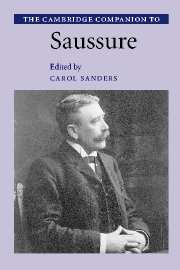Book contents
- Frontmatter
- Introduction: Saussure today
- Part I Out of the nineteenth century
- Part II The ‘Course in General Linguistics’
- 3 The making of the Cours de linguistique générale
- 4 The linguistic sign
- 5 Langue and parole
- 6 System, arbitrariness, value
- Part III After the Cours
- Part IV New debates and directions
- Notes
- Works by Saussure and further reading
- References
- Index
4 - The linguistic sign
from Part II - The ‘Course in General Linguistics’
Published online by Cambridge University Press: 28 May 2006
- Frontmatter
- Introduction: Saussure today
- Part I Out of the nineteenth century
- Part II The ‘Course in General Linguistics’
- 3 The making of the Cours de linguistique générale
- 4 The linguistic sign
- 5 Langue and parole
- 6 System, arbitrariness, value
- Part III After the Cours
- Part IV New debates and directions
- Notes
- Works by Saussure and further reading
- References
- Index
Summary
Language as a system of
Although linguists remember him for a whole range of theoretical and methodological shifts he introduced, Saussure's more general fame stems almost entirely from his conception of a language as a socially shared, psychologically real system of signs, each consisting of the arbitrary conjunction of an abstract concept and acoustic image. He was by no means the first to conceive of language in terms of signs (some of the precedents will be discussed in the next section), but in the late nineteenth and early twentieth centuries it tended to be philosophers and psychologists rather than linguists and philologists who taught and wrote about language in these terms. Already in 1894 he had noted the need for a sémiologie, a science of signs (see Godel, 1957: 182).
In his first course of lectures on general linguistics in 1907, Saussure stated early on that ‘A language is a system of signals: what makes the language is the relationship which the mind establishes among these signals’ (Saussure, 1996: 23; Godel, 1957: 54). The first course was planned as an overview of Indo- European historical linguistics as practised since the last third of the nineteenth century, with some general considerations on the nature of language inserted along theway, and Saussure did not pursue the semiological perspective further.
- Type
- Chapter
- Information
- The Cambridge Companion to Saussure , pp. 59 - 75Publisher: Cambridge University PressPrint publication year: 2004
- 12
- Cited by



